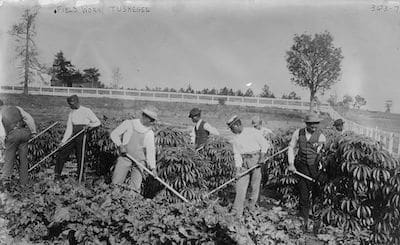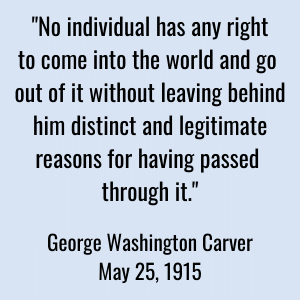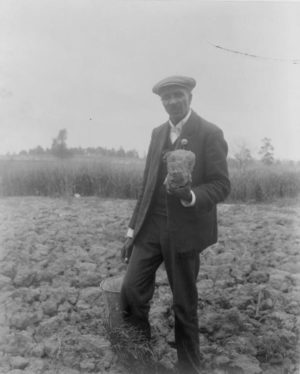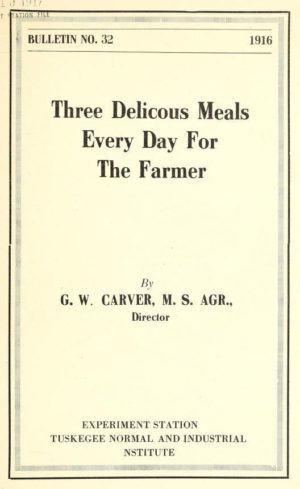
Field work in Tuskegee between ca. 1910 and ca. 1915. Source: Bain News Service, Publisher. Library of Congress, Prints and Photographs Division.
As the global population and our interdependence on food grown beyond the confines of our backyards and borders grows, connecting the dots between what we grow, how we grow food, and the impact of food on our health has a renewed interest for all of us. But these conversations are not new. Even though I previously have written about the foundation of mid to late 20th century farming practices to today’s regenerative agriculture practices, my history has been limited.
Upon reading a blog about George Washington Carver “writing the book on sustainability,” I was intrigued to dig deeper. Carver not only wrote the book on sustainability but connected the dots between what and how food is grown and its impact on health. Thanks to the vision and scientific curiosity of a man that has been associated more with peanuts than his broad scope of scientific endeavors, the basic concept of sustainable diets (nutrient-rich, affordable, culturally acceptable, and sparing of natural resources and the environment)1 actually goes back more than a century. We should give credit where credit is due! George Washington Carver understood sustainability.
From the Beginning

Even though there are accounts of disagreements between the workstyles of the two, Carver’s mission to pursue research remained his priority. He believed it was his “God-given mission to use his training as an agricultural chemist to help improve the lot of poor black and white Southern farmers.”2 As history notes, his arrival was timely as the abused soil of the South laid in ruins from years of over-farming cotton, compounded by the hunger and malnutrition experienced by the Freedman and poor whites following the Civil War.2
The Roots of Regenerative Ag

George Washington Carver, probably at Tuskegee (1906). Benjamin Frances Johnston, photographer. Library of Congress, Prints and Photographs Division. LC-USZ62-114302.
From the beginning of Carver’s time at Tuskegee, the core principles of regenerative agriculture surfaced as he showed the value of restoring the land where cotton had grown and depleted the soil of nutrients, with a rotation of nitrogen-fixing crops like peas and legumes. For example, on a one-half acre plot Carver increased the yield of sweet potatoes in a few years from 40 bushels to 266 bushels.2 He also introduced the concept of cover crops, the practice of keeping soil covered between plantings, so the soil would be replenished from the cultivation of cover crops for natural fertilizer. What made Carver believable is that he understood the practically of research as it related to the farmer’s bottom line. He realized the acceptance of new crops by farmers would only occur if there was a financial benefit. It was from this basic understanding, that he devoted his laboratory time to developing alternative uses for peas, sweet potatoes, soybeans and the lowly peanut. For example, from sweet potatoes, he developed flours, starches, sugar, a faux coconut, vinegar, synthetic ginger, chocolate and non-foods such as stains, dyes, paints and writing ink.2
The Sustainable Peanut
Even though Carver created numerous agricultural products, it was the peanut that raised his profile and improved the health status of the community around him. The peanut was a sustainable product that not only enriched the soil but also the body. The ready source of high-quality protein was vital during this time as meat was not affordable for many of the farmers with whom Carver worked. From the peanut, Carver discovered more than 300 food, industrial and commercial products ranging from milk, butter and meal to cooking oils, medicines and cosmetics.2
Communicating Science
George Washington Carver understood knowledge is only as good as the level of communication. During his tenure at Tuskegee, he wrote 44 bulletins from 1989 until his death in 1943 on subjects ranging from “Experiments with Sweet Potatoes” to “How to Build up Worn Out Soils” to “Fertilizer Experiments in Cotton” as well as more practical ones such as “How to Cook Peas” and “Three Delicious Meals Every Day for the Farmer.”2 Regardless of the subject, his approach mirrored a “farm to table” approach. As he stated, it was his goal “to supply simple cultivation information for farmers, a little science for teachers, and some recipes for housewives.”2
Understanding the Food and Health Connection

George Washington Carver’s booklet “Three Delicous [sic] Meals Every Day for the Farmer.” Source: National Agricultural Library.
Carver also understood the connection of diet and health as he noted the “ignorance in the kitchen was directly or indirectly responsible for more deaths than all the armies combined based on three criteria: poor selection of food, bad combination of food and bad preparation of food.”3 He went on to say that “I think I make a conservative statement when I say that 75 per cent of those who are entrusted with this important charge are deficient” and then listed several gastrointestinal ills that may occur! What is interesting, Carver’s meal plans adhered to the “eat like a king at breakfast, prince at lunch and pauper at dinner” and were plant centered with an emphasis on fruits, vegetables, legumes and dairy at every meal. It appears meat selections and quantities were based on what was home-grown during that time.
Respect the Past – Build the Future
As our dialogues continue over the months and years about the future of farming and how we are going to feed the world, let us reflect on the core principals George Washington Carver created, not only for sustainable farming and the connection of soil and personal health, but the spirit with which he connected with those he served. He said: “It is not the style of clothes one wears, neither the kind of automobiles one drives, nor the amount of money one has in the bank that counts. These mean nothing. It is simple service that measures success.”4 George Washington Carver was an inventor, scientist, agriculturalist, teacher, mentor, and above all else, a symbol to all.2 He was an individual who worked for economic and health equality and was respected for his racial harmony … a true success.
References:
1. “The Balancing Act-Nutrition and Sustainability: Understanding the Complexities, Challenges and Opportunities,” by Marianne Smith Edge, Nutrition Today, 2020; 55(2): pages 86-92.
2. George Washington Carver National Historic Chemical Landmark Commemorative Booklet, American Chemical Society, 2007. Download the booklet
3. “Three Delicous [sic] Meals Every Day for the Farmer,” George Washington Carver, 1916. Courtesy of the National Agricultural Library.
4. Quoted in “George Washington Carver: In His Own Words,” Gary Kremer, editor, University of Missouri Press, 1987, p. 17.
